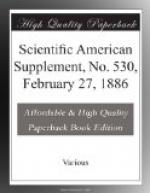On many nights no true dew is formed, and nothing but these exuded drops appear on the grass; and on all nights when vegetation is active, these drops appear before the true dew; and if the radiation is strong enough and the supply of vapor sufficient, true dew makes its appearance, and now the plants get equally wet all over, in the same manner as dead matter. The difference between true dew on grass and these exuded drops can be detected at a glance. The drops are always exuded at a point near the tip of the blade, and form a drop of some size, while true dew is distributed all over the blade. The exuded liquid forms a large diamond-like drop, while the dew coats the blade with a pearly luster.
Toward the end of the paper the radiating powers of different surfaces at night is considered, and after a reference to some early experiments on this subject, the paper proceeds to describe some experiments made with the radiation thermometer described by the author in a previous paper. When working with this instrument, it is placed in a situation having a clear view of the sky all round, and is fixed at the same height as the ordinary thermometer screen, which is worked along with it, the difference between the thermometer in the screen and the radiation thermometer being observed. This difference in clear nights amounts to from 7 deg. to 10 deg.. By means of the radiation thermometer the radiating powers of different surfaces were observed. Black and white cloths were found to radiate equally well; soil and grass were also almost exactly equal to each other. Lampblack was equal to whitening. Sulphur was about two-thirds of black paint, and polished tin about one-seventh of black paint. Snow in the shade on a bright day was at midday 7 deg. colder than the air, while a black surface at the same time was only 4 deg. colder. This difference diminished as the sun got lower, and at night both radiated almost equally well. In the concluding pages of the paper some less important subjects are considered.
* * * * *
A catalogue, containing brief notices of many important scientific papers heretofore published in the SUPPLEMENT, may be had gratis at this office.
* * * * *
THE SCIENTIFIC AMERICAN SUPPLEMENT.
PUBLISHED WEEKLY.
Terms of Subscription, $5 a Year.
Sent by mail, postage prepaid, to subscribers in any part of the United States or Canada. Six dollars a year, sent, prepaid, to any foreign country.
All the back numbers of THE SUPPLEMENT, from the commencement, January 1, 1876, can be had. Price, 10 cents each.
All the back volumes of THE SUPPLEMENT can likewise be supplied. Two volumes are issued yearly. Price of each volume, $2.50, stitched in paper, or $3.50, bound in stiff covers.
COMBINED RATES—One copy of SCIENTIFIC AMERICAN and one copy of SCIENTIFIC AMERICAN SUPPLEMENT, one year, postpaid, $7.00.




